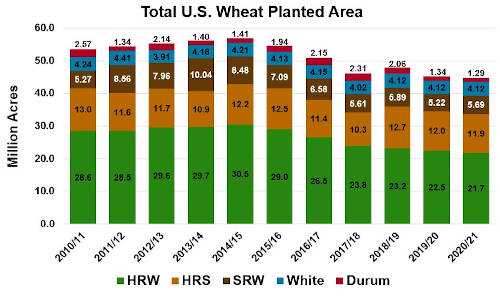By Claire Hutchins
According to the March 31 USDA Prospective Plantings report, U.S. total spring-planted wheat area is expected to fall to 12.6 million acres (5.1 million hectares), down 1 percent from 2019/20, if realized. This estimate includes 11.9 million acres (4.82 million hectares) of hard red spring (HRS), down slightly from last year. USDA expects U.S. durum planted area to total 1.29 million acres (522,000 hectares), down 4 percent from 2019/20. For all U.S. wheat, USDA now expects all wheat planted area for harvest in 2020 to total 44.7 million acres (18.1 million hectares), down 1 percent from 2019 and the lowest all wheat planted area since records began in 1919.

North Dakota farmers are expected to plant 6.10 million acres (2.47 million hectares) of HRS, 9% below last year. Last year’s overly wet field conditions affected HRS quality and led to significant cash price discounts at country elevators. According to Dr. Frayne Olson, Crop Economist and Marketing Specialist at North Dakota State University, farmers are “getting very frustrated with HRS quality discounts and the net price they receive at the elevator,” which he says is a disincentive for farmers to plant more HRS.
“I think the North Dakota HRS acreage number is a little low, but it may also reflect USDA concerns about Prevented Planting this spring,” said Dr. Olson. Farmers are eligible for crop insurance payments on fields when extreme conditions prevent them from planting a crop by a final, prescribed planting date, “There are areas in eastern North Dakota and western Minnesota that are going to have potential problems with Prevented Planting. However, that should not be an issue from central North Dakota to eastern Montana.”
The risk of quality challenges with HRS and more favorable marketing opportunities for soybeans compared to HRS also adds pressure to North Dakota HRS planted area. North Dakota producers are expected to plant 6.60 million acres (2.67 million hectares) of soybeans for harvest in 2020, up 18 percent from last year.
Of USDA’s prediction of reduced durum planted area, North Dakota Wheat Commission’s Market Development and Research Manager Erica Olson said, “North Dakota’s durum numbers surprised us a little bit, they were very low last year and we expected to see an increase this year.” USDA expects durum planted area in North Dakota to fall 11 percent on the year to 674,000 acres (273,000 hectares) as producers recoil from last year’s difficult, delayed harvest and cash price quality discounting.
Similar to the situation with HRS, North Dakota farmers are getting “very frustrated with durum quality cash price discounts” at North Dakota elevators, Dr. Olson said, “Farmers look at net income versus risk for growing each crop when deciding what to plant. If a farmer can raise Choice durum, net income is good. However, if you raise Ordinary durum, the math does not work. The risk to reward tradeoff has not been good the past several years.” Stable to slightly higher durum planted area in Canada adds pressure to U.S. durum prices which also discourages U.S. durum planted area.
In Minnesota, USDA predicts HRS planted area will fall 7 percent to 1.35 million acres (550,000 hectares), while soybean planted area will increase 8 percent to 7.40 million acres (3.0 million hectares) and corn planted area will increase 8 percent to 8.40 million acres (3.40 million hectares).
Charlie Vogel, Executive Director of the Minnesota Wheat Research and Promotion Council, has a slightly different opinion about the outlook for HRS.
“We expected HRS planted area to go down in Minnesota—two weeks ago, but it’s a different world now,” he said, citing the recent strong HRS futures rally attributed mainly to increased nearby domestic demand for bulk products.
“Given the futures rally, I now expect Minnesota HRS planted area could be in line with or slightly above last year’s acreage, if we get warm, dry planting conditions through spring,” said Vogel. However, if western Minnesota receives too much precipitation in the coming weeks, he does think farmers in certain areas may also be expected to make Prevented Planting claims for HRS.
Click here to see more...